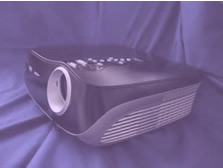|
Scalers: What are they and why do I need one, a brief overview
Scalers: Many folk seem confused as to what scalers actually are. The common belief is that they just de-interlace
SD material and then rescale it to some other resolution. Indeed when discussing scalers often the comments are
usually about what de-interlacing chipset is used above anything else. It's true that those are main features of
scalers but there is more to it than that. How they go about these tasks matter, as do some of the other features
a scaler can have that may offer increases in performance over in built video processing. Here's some of the things
we believe scalers should do.
Scalers are the glue that binds together a video system. Modern displays are not able to display our old and new
television standards without some form of processing being involved. Most of our video systems at home will have a
large and disparate range of sources with varying output resolutions and refresh rates. None of these sources are
likely to actually output a resolution or refresh rate that is optimum for our display! Good scalers are able to
be configured to optimise the capture and processing of all these signals and to then output them at the most
appropriate resolution and refresh rate for the source material and the display. Here are some examples:
Sources:
Satellite TV:
VCR:
DVD:
DVD:
ProgDVD:
ProgDVD:
HD Tape:
HD Satellite:
|
576i usually by SCART or svideo
PAL, Composite video
Region1, 480i@60Hz via Component or possibly HDMI
Region2, 576i@50Hz via Component or possibly HDMI
R1, 480P@60Hz via Component, HDMI or DVI
R2, 576P@50Hz via Component, HDMI or DVI
1080i@60Hz via Component or HDMI
1080i@50Hz or 720P@50Hz via component or DVI HDCP/HDMI
|
Displays:
SD plasma's... and clones
HD 42" plasma...
50" plasma and clones
Alis panels and clones
Pioneer 43" plasma
Pioneer 50" plasma
DLP's
DILA
SXRD
LCD
CRT Front Projection
|
852x480
1024x768
1366x768
1024x1024
1024x768
1280x768
1280x720 or 1024 x576
1365x1024 or 1400x800 or 1920x1080
1920x1080
1280x720, 1920x1080, 1366x768
Variable from 480P up to 1080P or more!
|
If you compare the source output resolutions with the displays actual resolutions you can see why we need scalers.
Standard definition signals in composite, s-video, component or SCART (RGBcvS) should be able to be processed
alongside HDMI, DVI, RGBHV, or High Definition component. These analogue signals should be sampled at a very
high rate in order to get good, accurate information to the front end of the system. The Digital inputs meanwhile
should be capable of accepting the full range of signals available from current sources from 480i up to 1080i.
Advanced greyscale, gamma and colour decoding combined with careful adjustment of input sizing should allow for
each source to be optimised for the most accurate and detailed playback. Over-scanning of the incoming signals
can be minimised and active picture area being sent to the display should be adjustable to allow the full picture
resolution to be displayed on screen. Digital video levels on input and output should be selectable for PC or VIDEO
dependant on source as required in order to gain maximum contrast with minimal banding artefacts.
Multiple inputs should allow direct connection of each source to the scaler, removing the need for switching of
video elsewhere which could degrade the signal quality and which would mean many components would have to share
the same input (compromising one or all of their picture quality).
Advanced powerful detection algorithms should work out whether the video material is from original progressive
content (film or PC graphics) or from interlaced video cameras and appropriate processing then should take place.
Original progressive images should be re-constituted to their full resolution frames then sent on to be up or
downscaled to the required resolution of the display. Accurate frame rate conversion should then be able to
output the progressive frames at the most appropriate rate eliminating judder and other temporal artefacts.
Clever filtering should be employed to remove harsh digital artefacts like mosquito noise, where appropriate.
Chroma filtering should be assignable on a per source basis for digital sources with mpeg decoders that suffer
from the famous, chroma bug.
Fast processing and as little buffering of the video signal as possible should be applied in order to minimise
potential lip-sync errors that may require the use of expensive audio delays. This processing should be able to
be updated to add further feature sets or to aid product compatibility.
If possible multiple memories should be available to allow quick and simple adjustments for more than one display
or perhaps for day and night-time viewing. The unit, once set up, should be extremely simple to use.
Advanced RGB gamma and overall LUMA adjustments may be available on a per input and memory basis. This would
allow ISF calibrators to make very accurate adjustments for greyscale where the capability wasn't present in
the display or where non linear tracking after calibration required further tweaking.
As we have a mixture of analogue and digital displays still it'd be wise for the scaler to have analogue outputs
that could be configured for RGB or YPrPb output, preferably on high quality 75ohm BNC connectors where high
resolution displays are going to be used. For digital displays DVI-D or HDMI outputs should be available. The
output resolution and timing parameters of the scaler should be adjustable in order to create the perfect
timings required to minimise artefacts on screen. In built test patterns should be available to help in set
up and confirmation of ideal scaler/display configuration.
With the advent of High Definition broadcasts about to start in the UK we'd expect that high definition inputs
should be available. These inputs should not just pass through an HD signal. There are many displays that are
not compatible with either the resolutions or the refresh rates of HD broadcasts. Good video processing should
be able to capture these HD signals and frame rate convert them and scale to allow compatibility with older displays.
The Lumagen range of processors we distribute meet some or all of these requirements. For advice on which unit
best suits your needs please contact us by phone or email: advice@convergent-av.co.uk
(Click here to go back to Articles archive)
Copyright ©2003-2005 Convergent-AV. Not For Re-Publication.
|



